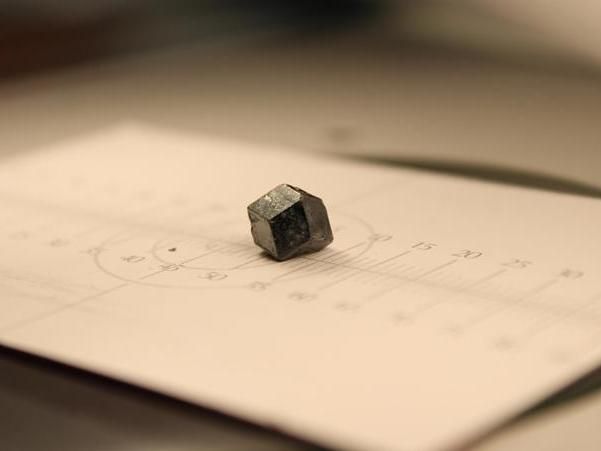Single crystal measures radioactivity
Affordable detectors for gamma radiation
A research team at Empa and ETH Zurich has developed single crystals made of lead halide perovskites, which are able to gage radioactive radiation with high precision. Initial experiments have shown that these crystals, which can be manufactured from aqueous solutions or low-priced solvents, work just as well as conventional cadmium telluride semi-conductors, which are considerably more complicated to produce. The discovery could slash the price of many radio-detectors – such as in scanners in the security sector, portable dosimeters in power stations and measuring devices in medical diagnostics.

Single crystals made of lead halide perovskites
Empa
Gamma photons virtually always accompany the radioactive decay of unstable isotopes. In order to identify radioactive substances, cost-effective and highly sensitive gamma detectors that work at room temperature are thus in great demand. Finding suitable substances, however, is easier said than done, as Maksym V. Kovalenko, a professor at ETH Zurich and research group leader at Empa explains: the coveted semiconductor has to be of an outstanding electronic quality, i.e. exhibit a high mobility and lifetime of carriers, along with a low density of trap states as well as of intrinsic carriers at room temperature. Second, it must be composed of heavy elements that can absorb highly energetic gamma photons. Third, it should be possible to grow large single crystals of this material and these crystals must be stable, both mechanically and thermally.
Classical beaker chemistry
Thus far, only cadmium telluride (CdTe) had fulfilled these requirements. However, the substance also used to produce thin-film solar cells is not water-soluble and only melts at temperatures above 1,000 degrees Celsius, which renders the production of detector crystals complicated and expensive. Kovalenko and his team have now succeeded in manufacturing single crystals from another family of novel semiconductors (lead halide perovskites) in a usual glass beaker at a cost of just a few Swiss Francs per crystal. These crystals can be used as highly sensitive detectors for gamma radiation.
One possible application might be a mini Geiger counter, which can be connected to smartphones. This might enable people in contaminated areas, for instance, to test their food for radioactivity.
Applications in neurodiagnostics
Another potential field of application for the new crystals is diagnosing metabolic problems in the brain. Dopamine receptor disorders can have numerous consequences: Parkinson’s, schizophrenia, hyperactivity (ADHD), social anxiety disorders or drug addiction and alcoholism. These disorders are diagnosed by giving patients radioactive tracer substances, which render the brain activity visible in magnetic resonance imaging (MRI). Administering radioactive substances is not without its hazards, though: if the substance is impure, it can have adverse health effects. However, its purity has to be verified swiftly as the tracer substance has a rather low half-life, which means it degrades rapidly.
In order to demonstrate the “capabilities” of lead halide perovskites, Kovalenko’s team used the new single crystal detector to test the isotope purity of 18F-fallypride, a tracer substance used in clinical trials on dopamine receptors. 18F-fallypride is radioactive and has a half-life of 110 minutes, which means there is precious little time to test the substance’s radioactive purity between its production and injection.
So far, purity measurements have been conducted in an elaborate, two-step process: first of all, the substance is separated using the high-performance liquid chromatography technique. In the second phase, the radioactivity is then measured with a detector. Thanks to the new crystal, the researchers were able to reduce this two-stage process successfully to one simple step. The crystal merely needs to be held in front of the tracer substance to take the readings.





















































